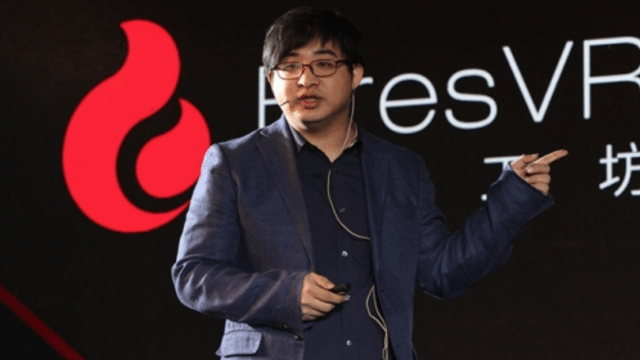FiresVR aims to make VR tech more accessible and economical
It has created its own VR operating system, JiDome OS
You may have heard of a lot of technology companies, but can you imagine one running for its first eight months without a CEO? Well, that’s what this company has done.
Chinese virtual reality (VR) company FiresVR works to provide VR-related technologies and content to makers of VR headsets. They are also making a series of their own hardware products.
From news editor to VR startup CEO
FiresVR CEO Lou Chi was formerly an associate editor at the Tech news channel of Tencent, which runs one of China’s largest news portals. He started tech journalism as a sophomore, and later earned fame with his sharp and critical writing. Eventually, though, he wanted more from his career.
“I have witnessed numerous entrepreneurial opportunities, one wave after another: internet, mobile internet, games, e-commerce and VR. I wanted to do something different,” Lou told AllChinaTech.

Luo Chi, FireVR CEO.
Lou said that the past 10 years in the media industry had offered him opportunities to get to know some of the best technicians in the VR industry, including the man who was to become FiresVR CTO, Wang Mingyang. Wang Yangming had previously been the CEO of mobile security software producer LBE, and a VR project leader at video media platform Baofeng.
“I saw a VR headset in 2013 and was completely shocked and intrigued, even though it was only a simple one, like a Google Cardboard,” said Lou.
At that time, Lou was still at Tencent Tech, but he set his mind to founding a VR company. He joined with the aforementioned Wang Mingyang, as well as Zhang Chuang, Lou’s best friend and former editor-in-chief of the Tencent digital channel. Zhang Chuang is currently COO of FiresVR.
Also Read: Singaporean’s idea to let fans experience F1 live using VR wins him US$50K in Texas F1 competition
The company was mainly working on some technical issues – like the VR algorithms – during the first months, so, in the words of Lou, “the company could go without a CEO.”
FiresVR was founded in Beijing in October 2014, but it was not until June 2015 that Lou resigned from Tencent and became the CEO of FiresVR.
Improving technology to make VR affordable
FiresVR now has 30 staff, 24 of whom are technical staff. Lou said that most of the technical staff have been in the VR industry for about two years — a long time by the standards of the China market, by Lou’s reckoning.
“The VR industry was still at its very beginning a year ago. Many VR players rushed to make plastic versions of Google Cardboard and put them into the market. FiresVR was one of the few companies that took longer to create their technology,” said Lou.
Since the beginning, the company has had the ability to make their own VR glasses, VR glasses attached to smartphones, and even all-in-one headsets. Nevertheless, they prefer to be a technology provider to other companies first. Their technologies have benefited many VR headset makers, especially those in the southern coastal city of Shenzhen.
It also has created its own VR operating system, JiDome OS, as well as the JiDome Store, which contains a large number of VR videos and games by other VR content producers, and several VR games of its own. FiresVR will charge a license fee to companies who use it.

JiDome VR glasses. Photo from FiresVR.
The company launched a set of VR glasses called the JiDome in December 2015. The JiDome is a customized VR headset which draws lessons from the Samsung Gear VR, but with a lower price, being sold at RMB 199 (US$29.8). The JiDome will be put on sale in November this year.
Lou saw the Baofeng Mojing-5 as the main rival of the JiDome in China. He said that FiresVR would introduce to other companies the technologies used in the JiDome.
Also Read: HTC and its stark future in virtual reality
FiresVR’s ambition was eventually backed by investors: the company landed RMB 10 million (US$1.48 million) in an angel round of funding in August 2015, and was then valued at RMB 100 million (US$14.8 million)
Making products more accessible
According to the market research firm IDC, worldwide shipments of VR hardware will reach 9.6 million by the end of 2016, and the VR/AR hardware markets combined will see shipments of 110 million by 2020.
It seems that users in Western markets have a stronger interest in VR headsets that need to be attached to computers or game consoles, like the Oculus Rift and HTC Vive. Chinese domestic VR makers started off with simple Google Cardboard-like products, which some people thought of as less promising in comparison to VR products like the Oculus Rift and the HTC Vive. But Lou thought otherwise.

JiDome OS. Screened from Vrfires.com
“The Cardboard-like products seem to have nothing to do with the ‘high-end’ of the market, but the shipments of these kinds of VR headsets have reached eight million units per year from Shenzhen alone. These are the products favoured by the majority, rather than the high-end ones,” said Lou.
When it comes to all-in-one VR headsets, Lou thought that the current technology level was not efficient enough to make the price acceptable for a majority of people. In China, a decent all-in-one VR product costs around RMB 3,000 (US$443).
Lou holds the same opinion for augmented reality (AR), another important emerging technology. He said that there is still a long way to go before AR hardware products will be accessible to ordinary users. This is even more the case when the U.S. is leading the technical development of AR, and China is a follower.
Also Read: Virtual reality arcades are booming in Shanghai
“Looking at it from a long run perspective, VR is only part of, or maybe an early form of, AR. AR has a much higher value than VR, but AR headset makers still have many problems that need to be to solved, including the product weight and battery life,” said Lou.
“FiresVR will continue developing technologies in this field, and we aim to make the VR experience accessible to more users at a lower cost.”
—
The original article “FiresVR aims to make VR tech more accessible and economical” first appeared on AllChinaTech.
The post FiresVR aims to make VR tech more accessible and economical appeared first on e27.



